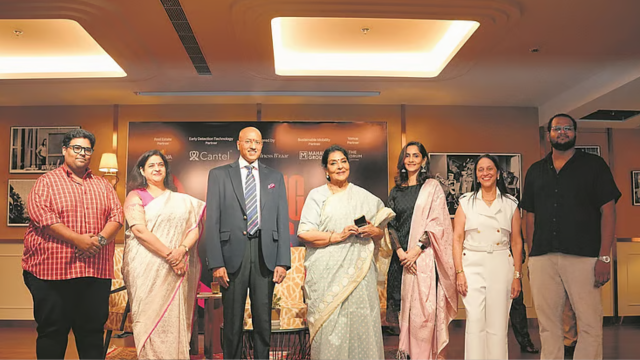October 29, 2025 : Every year, October sees the world donning pink ribbons in solidarity for breast cancer awareness—but behind the colour and campaigns, many voices remain unheard and vital conversations remain hushed. Breast cancer remains the most commonly diagnosed cancer among women globally and a leading cause of cancer-related deaths in many settings.
The phrase “breaking the silence” is more than symbolic: it’s about challenging stigma, opening up about risk, elevating early detection, ensuring equitable access to care, and supporting everyone affected by the disease—including younger women, men with breast cancer, survivors and caregivers.
The Care Gap and Why Silence Persists
According to the World Health Organization (WHO), in many low- and middle-income countries, breast cancer is often detected at later stages due to limited screening, delays in diagnosis, lack of awareness or cultural barriers. That delay translates into lower survival rates—while in high-income regions 5-year survival can exceed 90 %, in other regions survival drops significantly.
In India, for example, local media reports show that in regions like rural Punjab, a large proportion of cases are diagnosed at stage III or IV—when treatment is more complex and outcomes poorer.Meanwhile, a UK study found that two-thirds of women weren’t performing regular self-exams, citing forgetfulness, lack of confidence or simply not knowing how.
Silence persists because of multiple reasons: fear, social stigma around detecting something “wrong”, limited knowledge about breast health, and sometimes cultural taboos around discussing bodies. The result? Many women delay seeking help, or skip screening. This silence isn’t passive—it has serious consequences.
Why Early Detection Matters
As the U.S. Centers for Disease Control and Prevention (CDC) points out, mammograms and clinical breast exams are among the best tools to catch breast cancer early—before symptoms even appear. When caught early, the chance of effective treatment goes up significantly.
Symptoms can range from subtle to obvious: a new lump, changes in breast shape or size, nipple discharge (other than breast milk), skin changes on the breast, or underarm swelling.
But notably, not all cases present obvious signs, which is why routine screening and awareness of “how your breasts normally feel” are key. Educating oneself and one’s family is vital.
Risk Factors & What You Can Control
While some factors (age, gender, family history, genetic changes such as BRCA1/2) cannot be modified, many lifestyle factors can influence risk. The Union for International Cancer Control (UICC) notes that up to 25 % of breast cancer cases are linked to modifiable risk factors: maintaining healthy weight, staying physically active, limiting alcohol use, avoiding tobacco exposure, and breastfeeding when possible.
This isn’t about blame—it’s about empowerment. Recognising what we can influence gives us part of the control back.
Challenges Beyond Awareness: Access and Equity
Even when awareness is raised, access to screening and quality care is uneven. WHO’s Global Breast Cancer Initiative emphasises the “60-60-80” targets: 60 % of invasive breast cancer diagnoses at stage I or II, diagnosis within 60 days of presentation, and 80 % of patients completing recommended treatment.
In resource-constrained settings, barriers include cost, long travel distances, limited specialist availability, delays in biopsy or pathology, and treatment drop-out due to financial or social support issues. Without addressing these structural issues, awareness campaigns alone cannot close the outcome gap.
Survivorship, Support & Breaking Myths
Survivors’ voices matter. The narrative of breast cancer is moving beyond “fight” metaphors to include real stories of diagnosis, treatment, side-effects, emotional roller-coasters and post-treatment life.
Support includes peer groups, counselling, financial guidance, and long-term follow-up for physical and psychological effects. In many countries NGOs such as The Pink Initiative in India offer awareness, education and survivor networks.
Men and non-binary people with breast cancer also require inclusion; their cases are rarer but often diagnosed late due to low awareness.
Myths abound—such as “if I have no family history, I am safe”, or “breast cancer only happens after 50”, or “small breasts don’t get cancer”. These false beliefs deter timely screening or action. Breaking silence means confronting myths head-on, turning knowledge into practice.
What Each of Us Can Do
Here are practical steps everyone can consider:
- Know your normal — become aware of how your breasts normally look and feel so you can notice any changes.
- Follow screening guidelines — consult your doctor about when to begin mammograms, ultrasound or other tests based on your risk. (E.g., in many places starting at age 40 or 50, or earlier if high risk)
- Advocate for access and equity — support campaigns or local programmes that aim to bring screening and care to underserved communities.
- Monthly self-check — simple, low-cost, done at home, can help identify early changes.
- Adopt healthier lifestyle habits — maintain a healthy weight, stay active, limit alcohol and tobacco, consider breastfeeding if applicable
- Encourage and help others — talk openly, reduce fear and stigma, support friends/family members to attend screenings.
Looking Ahead
While awareness months (October is globally designated as Breast Cancer Awareness Month) play a vital role in fundraising, advocacy and education, the real work happens year-round: ensuring earlier detection, better access to diagnostics and treatment, supporting survivors, and tackling the structural inequities that persist.
In the 21st century, survival rates are improving—thanks to medical advances, but the full promise of those advances will only be realised when detection is early, care is timely, and no one is left behind. The message is clear: the more we talk, the more we share, the more we act—the less silent the disease becomes and the more lives we can save.
Summary
Breast cancer remains common but treatable when detected early. Breaking the silence—through awareness, screening, lifestyle change, equitable access and survivor-voices—can shift outcomes and empower everyone affected.


